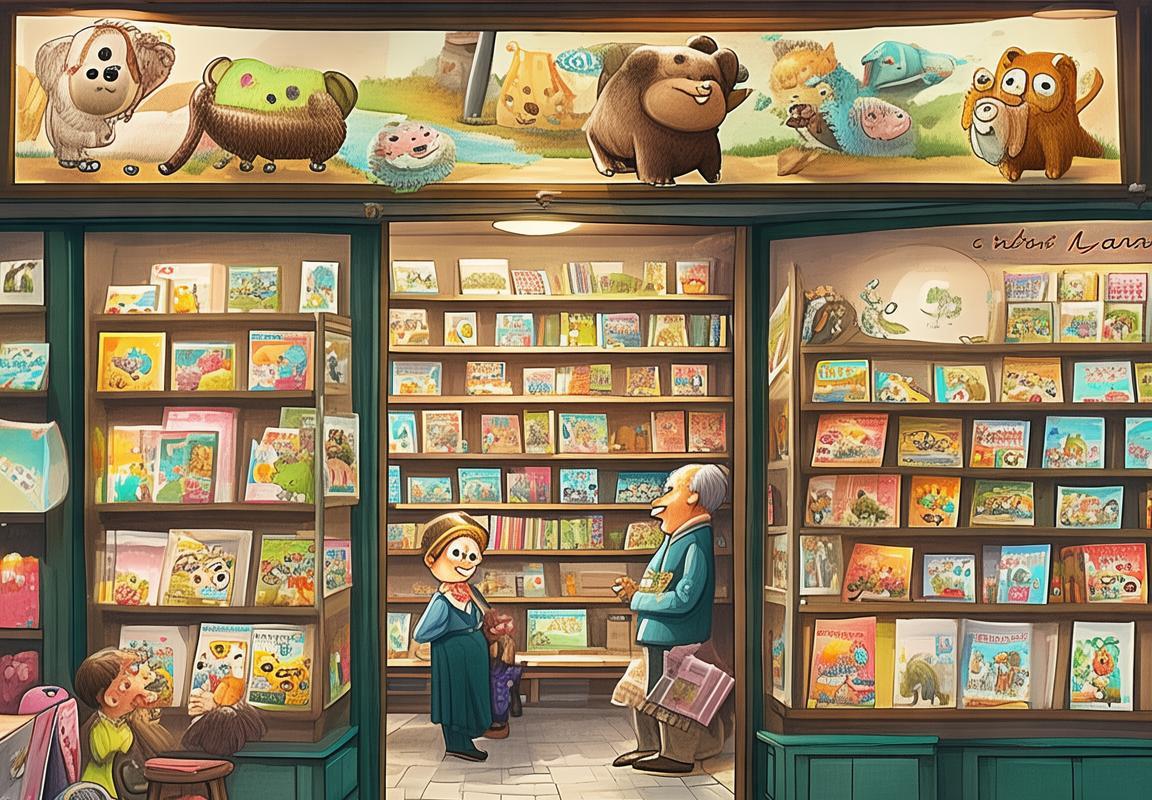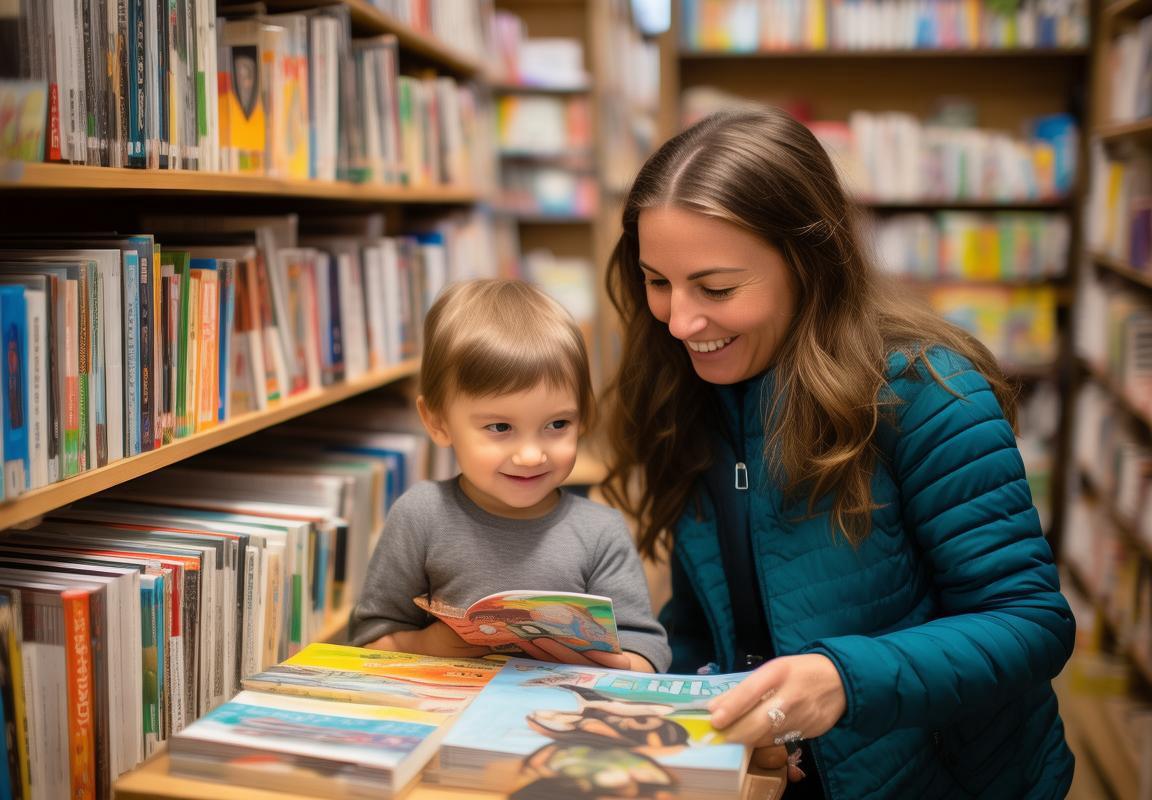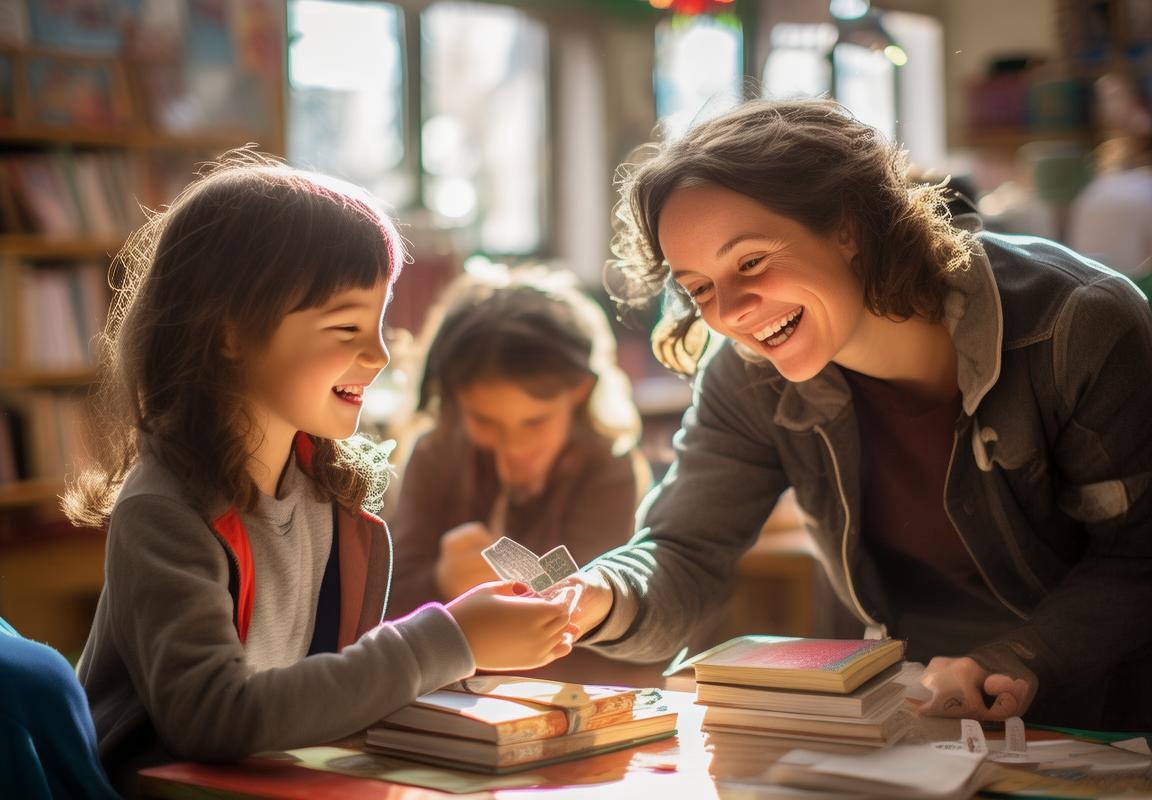และก็เพราะเป็นเรื่องที่เรียบง่ายและน่าสนใจ นั่นจึงทำให้เราตั้งใจที่จะสร้างเนื้อหาเรียนรู้เกี่ยวกับสัตว์น้ำและทะเลในภาษาอังกฤษ โดยให้ความสำคัญต่อการสร้างภาพภายในใจของเด็กเกี่ยวกับสิ่งแวดล้อมที่เป็นมหัศจรรย์และกว้างขวางนี้ นอกจากนี้ การเรียนรู้เกี่ยวกับสัตว์น้ำและทะเลยังช่วยให้เด็กมีความสำคัญต่อการปฏิบัติตามธรรมชาติและรักษาสิ่งแวดล้อมอย่างดีที่สุด จงรู้สึกกับเราเพื่อเริ่มต้นการเรียนรู้นี้กับเรื่องราวที่น่าตื่นเต้นของสัตว์น้ำและทะเลเพื่อเด็กทุกคน!
ขาวงานเข้าร้าน
หน้าแรก: รายละเอียดภายนอกร้าน
- “Look at the colorful signs! This is a bookstore, isn’t it?”
- “Yes, that’s right! Bookstores are magical places where we can find stories from all over the world.”
หน้าที่ 2: ขาวงานเข้าร้าน
- “Can we go in, please?”
- “Of course! Let’s say, ‘Excuse me, may we come in?’”
หน้าที่ 3: ชมหนังสือที่ชั้นหน้า
- “Wow, there are so many books here! Look at the pictures of animals.”
- “Yes, there are books about animals, adventures, and even science. Let’s ask, ‘Do you have any children’s books about animals?’”
หน้าที่ 4: ค้นหาหนังสือที่ชอบ
- “I like this one. It has a picture of a bear.”
- “That sounds interesting! You can say, ‘I would like this book, please.’”
หน้าที่ 5: ชำระค่าเงิน
- “How much does this book cost?”
- “Let’s ask the shopkeeper. You can say, ‘How much is this book?’”
หน้าที่ 6: ขายหนังสือและกลับบ้าน
- “Here you go, your book. Thank you!”
- “You’re welcome! Remember to take care of your book. Reading is fun and it helps us learn new things.”
หน้าที่ 7: หมายเหตุ
- “It’s important to be polite when we buy things. We say ‘please’ and ‘thank you.’”
- “And always ask for help if we don’t understand something.”

ชมหนังสือที่ชั้นหน้า
- ดูเห็นหนังสือที่ชั้นหน้าร้านขายหนังสือ
- “Look at all these books on the shelves. They’re so colorful and interesting!”
- วางตัวต่อตัวหนังสือแตกต่างกัน
- “This one has a picture of a cat. And this one has a dog. Look, there’s a book with a tree!”
- กล่าวถึงสีของหนังสือ
- “This book is red. And that one is blue. Books can be many different colors.”
- วางตัวต่อตัวหนังสือโดยอาศัยสี
- “Let’s put the red books together. And the blue ones here. It’s fun to sort them by color.”
- อ่านชื่อหนังสือ
- “This book says ‘The Cat in the Hat’. Do you like cats?”
- ชมหนังสือที่มีภาพอะไร
- “Look, this book has a picture of a sun. And this one has a moon.”
- ชมหนังสือที่มีภาพสัตว์
- “This book has a picture of a lion. And that one has a giraffe.”
- อ่านชื่อหนังสือที่มีภาพสัตว์
- “This book is ‘The Lion King’. Do you know any lions?”
- ชมหนังสือที่มีภาพดอกไม้
- “This book has a picture of a rose. And that one has a daisy.”
- อ่านชื่อหนังสือที่มีภาพดอกไม้
- “This book is ‘Flowers in the Garden’. Do you like flowers?”
- ชมหนังสือที่มีภาพอากาศ
- “This book has a picture of the sky. And that one has the ocean.”
- อ่านชื่อหนังสือที่มีภาพอากาศ
- “This book is ‘The Sky and the Ocean’. Do you like the sky and the ocean?”
- ชมหนังสือที่มีภาพที่มีความหมาย
- “This book has a picture of a house. And that one has a car.”
- อ่านชื่อหนังสือที่มีภาพที่มีความหมาย
- “This book is ‘The House and the Car’. Do you like houses and cars?”
- กลับมาที่หน้าแรกและจบ
- “Let’s go back to the front. I’m so happy to see all these books. They make me want to read!”

ค้นหาหนังสือที่ชอบ
เมื่อเด็กเริ่มหาหนังสือที่ชอบในหน้าแรกของร้านหนังสือ พวกเขาอาจจะพบกับหลากหลายประเภทของหนังสือที่มีสีสันประกอบและรูปภาพที่ต่างกัน นี่คือเวลาที่เด็กจะรู้สึกว่ามีหลายๆ หนังสือที่เขา/เธออาจจะชื่นชอบ
-
เด็ก (D): “Look at this book! It has a picture of a cat.”
-
อาจารย์ (T): “Yes, that’s a nice book. Do you like cats?”
-
D: “Yes, I love cats! Do you have any books about dogs?”
-
T: “Certainly! Let’s find a book with a picture of a dog.”
เมื่อเด็กได้หาหนังสือที่มีสิ่งที่เขา/เธอชอบ อาจารย์จะช่วยเด็กในการเลือกหนังสือดังกล่าว
-
T: “Great! This book has a picture of a dog. It’s perfect for you.”
-
D: “I want this book! Can I have it, please?”
หลังจากที่เด็กได้เลือกหนังสือที่ชอบ อาจารย์จะช่วยเด็กในการชำระค่าเงินและช่วยเขียนชื่อของเด็กบนหนังสือ
-
T: “How much does this book cost?”
-
D: “I don’t know. Can you ask the shopkeeper?”
-
T: “Of course. You can say, ‘How much is this book?’”
หลังจากที่เด็กได้ชำระค่าเงินแล้ว อาจารย์จะช่วยเด็กในการเอาหนังสือออกมาและช่วยเขียนชื่อของเด็กบนหนังสือ
-
T: “Here you go! This is your book. Remember to take care of it. Reading is fun!”
-
D: “Thank you! I will take care of my book.”
เรื่องราวหนังสือนี้ไม่เพียงแค่ช่วยเด็กในการเรียนรู้ภาษาอังกฤษแต่ยังช่วยพัฒนาความรับรู้เกี่ยวกับสิ่งที่เขา/เธอชอบ และสร้างความชื่นชอบต่อการอ่านหนังสือเช่นกัน

ชำระค่าเงิน
เมื่อเด็กกลับมาถึงร้าน และเต็มใจที่จะชำระค่าเงิน อาจารย์จึงช่วยเด็กในการเลือกว่าจะใช้เงินไปทางไหน
-
D: “I want to buy this book. How much is it?”
-
T: “Let’s ask the shopkeeper. You can say, ‘How much is this book?’”
-
Shopkeeper: “That book is ten dollars.”
-
D: “Ten dollars? I only have five dollars.”
-
T: “You can say, ‘I have five dollars, but I need ten dollars to buy this book.’”
-
D: “I have five dollars, but I need ten dollars to buy this book.”
-
T: “That’s right, D. You can say, ‘I need five more dollars to buy this book.’”
-
D: “I need five more dollars to buy this book.”
-
T: “The shopkeeper will give you some change. You can say, ‘Can I have five dollars in change?’”
-
Shopkeeper: “Of course, here you go.”
-
D: “Thank you very much!”
-
T: “You’re welcome! Now you can take care of your book and enjoy reading it.”
ด้วยวิธีนี้ เด็กได้เรียนรู้ภาษาอังกฤษในสถานการณ์ที่มีความสำคัญและมีความสนุกสนาน ทั้งที่จะชำระค่าเงินและชอบชายหนังสือที่เขาชอบอย่างมาก。

ขายหนังสือและกลับบ้าน
เมื่อเด็กกลับบ้านหลังจากไปซื้อหนังสือที่ร้านขายหนังสือ พวกเขามีการสนทนาอย่างน่าสนุกกับอาจารย์เกี่ยวกับประสบการณ์ของพวกเขา:
-
เด็ก (D): “Teacher, I bought this book! It’s about animals in the forest.”
-
อาจารย์ (T): “That sounds amazing, D! I’m glad you found a book you like. What did you say to the shopkeeper when you bought it?”
-
D: “I said, ‘Excuse me, I want this book, please.’ The shopkeeper smiled and gave it to me.”
-
T: “Good! It’s important to be polite when we’re shopping. Can you remember to say ‘Thank you’?”
-
D: “Yes, teacher! I said ‘Thank you’ to the shopkeeper.”
-
T: “That’s the spirit! Now, let’s talk about the book. What color is the cover of your book?”
-
D: “It’s green!”
-
T: “Green is a beautiful color. Animals in the forest can be many different colors. Now, let’s go back home and read your new book together.”
-
D: “Yay! I can’t wait to read it!”
-
T: “Me too, D. Reading is a great way to learn and have fun. Remember, every time you read, you’re opening a new world for yourself.”
-
D: “I will, teacher. Thank you for helping me learn English!”
-
T: “You’re welcome, D. I’m here to help you. Now, let’s go and enjoy your new book!”
-
D: “Bye, teacher!”
-
T: “Bye, D. Have a great day!”
